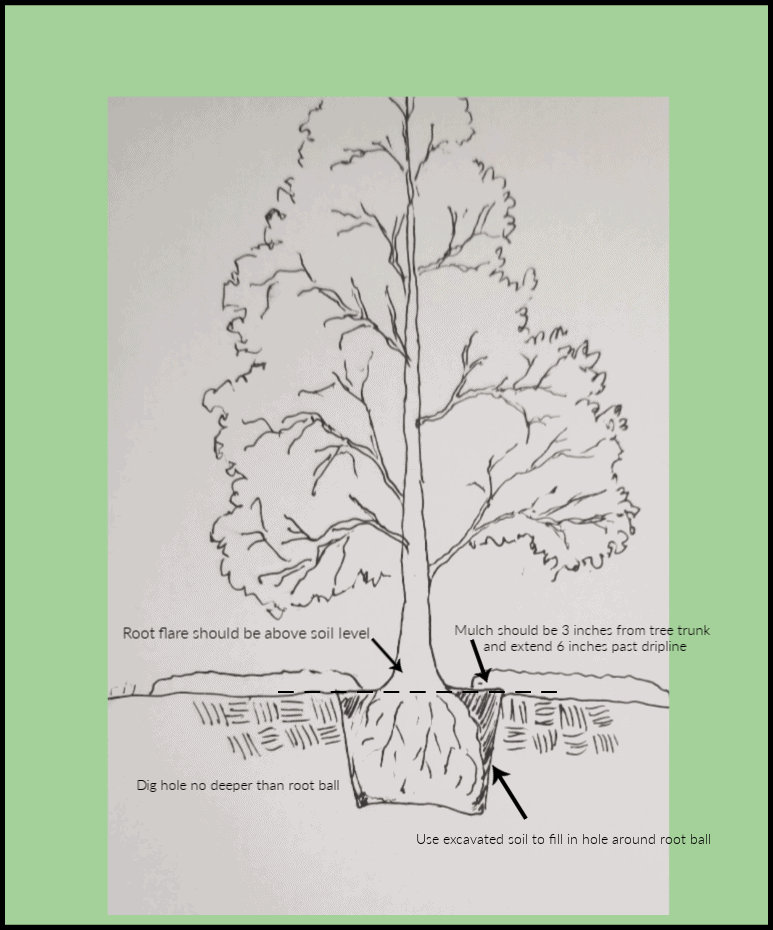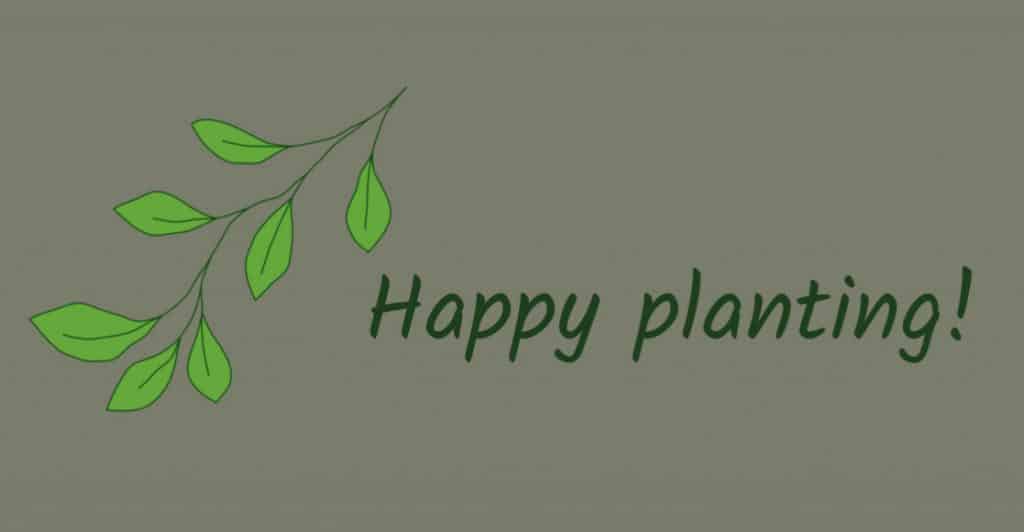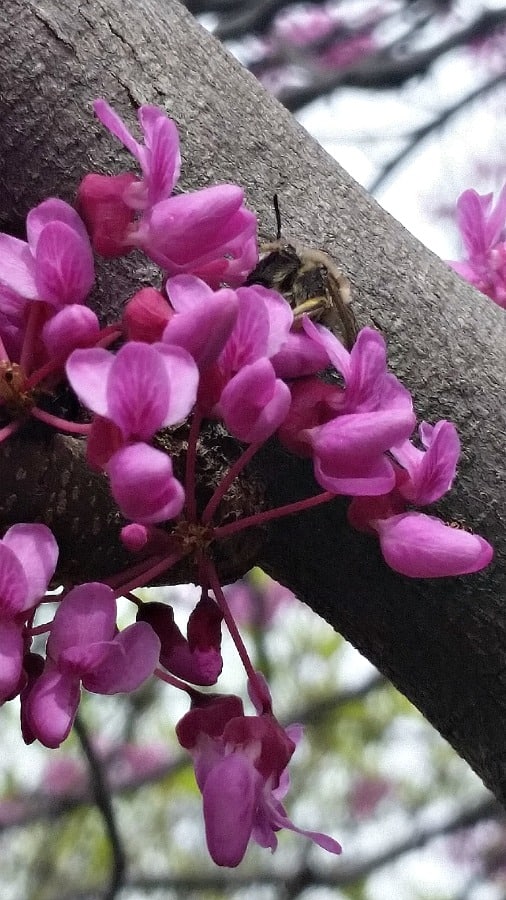Redbud ‘The Rising Sun’ is a powerhouse performer all year long. This small tree has multi-season interest for the whole landscape. It grows in full sun to part shade. Plant it next to the house, under power lines, or in a grouping of 3 or more in the middle of the lawn. Redbuds are native to the United States, from Texas to Canada and from New York to the Rockies. They fit into a wide range of soil types and weather extremes.

Plant Description
Redbud ‘The Rising Sun’ is a smaller tree than the typical wild one. It grows 15 feet tall and wide. It grows where many other trees will not. Its new growth is orange to yellow, giving it its name. Redbuds are known for their spring flowers and this one is no exception. It has bright purple-pink flowers in mid spring, that are attractive to honeybees and other pollinators.
Redbuds have many great attributes. The textured bark is dark brown and scaly. Fall color is yellow to brownish-yellow.
Where to Buy Redbud ‘The Rising Sun’
Our garden store is located centrally between Hiawatha, KS, Sabetha, KS, and Falls City, NE. The address is 2991 Goldfinch Road, Hiawatha, KS. We also have an online retail center. Check out our selection at our webstore.
Redbud Problems
Redbuds are not prone to a lot of pests and diseases, but are host plants for a variety of moths and butterflies, including the Eastern Tiger Swallowtail Butterfly and the Emperial Moth. If planted in too wet a location, it may develop some powdery mildew, but not enough to cause damage to the tree.
Redbud leaffolder moths can also cause some aesthetic damage. These caterpillars roll the leaves of the tree to protect themselves while feeding. They do not cause enough damage to weaken the tree. I have also seen leaf-miner on the leaves.
Where to Plant Redbuds
Redbuds are best planted as understory trees or in groups of 3 to 7. It has been discovered that trees do better when planted in large groupings, not individually in an open lawn or field. ‘The Rising Sun’ redbud does very well planted near a house that has a dark exterior, or as an understory tree in a shade garden.
How to Plant a Redbud
When you get your tree from Grimm’s Gardens, it will be in a white, fabric grow bag. These cloth bags promote better root health and prevent the roots from circling and choking the tree.
Remove the grow bag by using a knife to cut the bag vertically on two sides, then rip the bag from the root ball by force. This will not damage the roots; it prepares them for planting.
Dig the hole to the depth of the root ball and just slightly wider than the root ball. Place the tree into the hole and use the excavated soil to fill in around the root ball. Make sure the trunk is straight as you fill the soil in.

How to Water Your Redbud After Planting
Newly planted trees need to be watered daily for a few weeks after planting. After you have your tree in the hole, use a garden hose to water it in. Stick the hose into the bottom of the hole from the side, and turn on the water. This will help the soil to settle around the root ball and prevent air pockets.
Once the water starts bubbling up out of the hole, move the hose to the other side of the hole and repeat the above step. Turn off the hose and spread soil into the hole where it has settled, until it is at the original soil level.
Water your tree once daily with a hose on a trickle for 10 minutes. Do this everyday for 2 weeks when the temperatures are 65 degrees or hotter. After 2 weeks, cut watering back to every 3 days; do this for 2 more weeks.
After 2 weeks of watering every 3rd day, cut back to 1 time per week for the rest of the year (through January if the temperatures are above 40 degrees and there is no snow or rainfall). If you get significant rainfall (1″ per day or week) at anytime during the year, do not water during those weeks.

My favorite tree is a redbud because they are native and so striking as they peak through the timber in the spring. This new variety has interesting foliage that changes with the seasons. – Nadine Champlin, Landscape Designer at Prairie Place Designs
Plant a redbud ‘The Rising Sun‘ in your landscape today by calling Grimm’s Gardens!





I have four of these and would like three more. When will they be in stock?
Does the rising sun redbud have a lot of seed pods? I read that the hearts of gold redbud and the lavender twist do not but I like the colors of the rising sun. Please advise.
I planted my rising sun redbud last May. This year it is lemon lime green and the leaves have a crappy appearance to them. What am I doing wrong? I’m so sad because I fell in love with the very first rising sun redbud tree I ever saw. They have so much personality and I want to make mine healthy
Hi Lisa,
Thank you for your comment and question. It is possible that the tree is suffering from some form of discoloration due to excessive heat or sunlight. Also, is has there been any damage from wind or hail? I know here in the Central Great Plains we have had several wind events and many saw hail in April and May, which has caused leaves on a lot of trees to appear damaged, torn, and deadened. If you would like a better analysis, you can send photos to [email protected] and I can try to diagnosis from them.
Thank you,
The Kansas Gardener
My understanding is that a lemon-lime leaf is expected for new growth on the Rising Sun Redbud and the leaves turn apricot-colored later in the season. Would love an update and wonder if that is what happened with yours m
Hi Susan, thank you for reading! The new growth is lime or chartreuse green and ages to a apricot-orange color. Since first planting these trees in Northeast Kansas, I have seen much better and longer lasting color than in the first couple of years. New growth usually remains on the tree for up to a month.
Andrew Mitchell
My recently planted Rising Sun Redbud is growing beautifully on the sides but not in the crown. It was planted in the spring of 2022. Will the crown develop with time or is there a problem that I should look into. Thanks. I live in Nocatee in Ponte Vedra FL
Hi Zach,
The top of your tree should develop over time, but you may want to check the central leader and see if it is dead, or is growing slower than the side branches. If the side or lateral branches are longer than the leader, then perform a heading cut on the laterals, removing 6 to 10 inches back to a bud, which should induce the leader to grow more.
Thank you,
Andrew Mitchell
ISA Certified Arborist